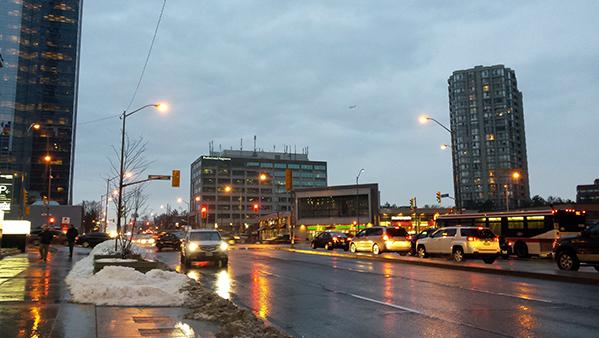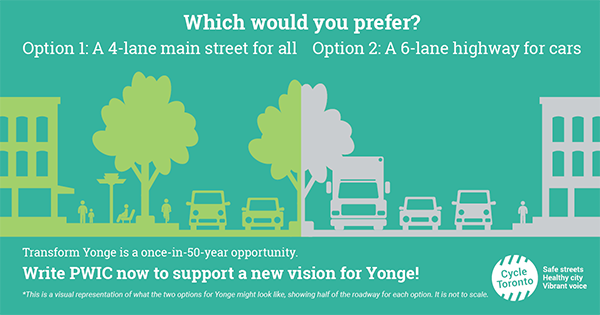
Why Transform Yonge is the only way forward

February 20, 2018
Dear Mayor Tory:
We are a coalition of individuals and organizations who care deeply about making Toronto’s streets safe, liveable, and vibrant for all. We are writing to express our support of the Transform Yonge option from Stage 1 of the REimagining Yonge project.
This letter explains our reasons for urging you to vote in favour of implementing the City staff-recommended Transform Yonge option, bringing a new vision for North York to life.
Imagine yourself as a pedestrian standing at the corner of Yonge Street and Sheppard Avenue on a spring day. You’re surrounded by six lanes of car traffic. The air is choked with exhaust from idling vehicles. You’re above one of the city’s busiest transit hubs, but the sidewalks are too narrow to accommodate the swells of commuters. You’d like to sit down for a coffee, but none of the nearby restaurants or cafes have reliable outdoor seating. You notice that families with strollers and people using mobility devices are struggling to navigate the uneven sidewalks.
Do you feel like you belong here?
Photo: Jesse James, Willowdale Community Outreach Worker
In its current condition, Yonge is not a destination. It’s a six-lane transportation corridor for motor vehicles, not a street for people walking, riding bikes, and taking transit. Its sidewalks aren’t wide enough to meet the needs of the 80,000 pedestrians living within walking distance of this corridor. It lacks safe crossings, resulting in frequent collisions between cars and vulnerable road users. It has no cycling infrastructure, leaving people in the dangerous position of having to ride with high volumes of fast-moving traffic or leaving their bikes at home. Its public realm is in sore need of attention, with barely any seating, and trees that are small and poorly maintained. All of these conditions leave Yonge failing to serve thousands of local residents, businesses, and Torontonians who spend time here.
The Transform Yonge option would address every one of these problems. It’s a chance to dig in our heels and actually follow through on building a 21st century, Vision Zero city rather than settling for incremental changes that preserve the status quo. Our judgement is based on a thorough examination of the January 12 Staff Report recommending the Transform Yonge option and our collective decades of experience with city-building and road safety.
We urge you to consider the following three points in favour of the Transform Yonge option:
1. It would honour Toronto’s commitment to Vision Zero.
We applaud the City for making a bold commitment to ending traffic deaths and serious injuries by 2021. Transform Yonge is a perfect example of Vision Zero in action, moving beyond words and promises to results, as is happening in other Vision Zero cities including New York and San Francisco. The current configuration of Yonge does not support an appropriate balance of safety and traffic throughput for a dense, mixed-use neighbourhood where over half of residents are using non-driving modes of transportation. The inadequate sidewalks, absence of cycling infrastructure, and paucity of seating and trees send the message that street life doesn’t matter.
There have been 83 collisions involving vulnerable road users in the study area since 2010, including eight resulting in serious injury or death. Every one of these tragic deaths could have been avoided with better road design. Unfortunately, we know it’s only a matter of time before another person walking or cycling is seriously injured or killed along this corridor. How many lives are worth putting off desperately-needed safety improvements?
2. It would create the kind of vibrant public realm that North York deserves.
Transform Yonge is an opportunity to make a more livable corridor in an area that could truly be a downtown North York. Residential and mixed-use developments have brought rapid population growth to North York Centre. The population density here is comparable to downtown Toronto, and has resulted in high pedestrian volumes: surveys administered as part of the City’s public engagement process found that 80% of area residents travel by foot. More broadly, the Staff Report identifies a recent shift in transportation choices, with more residents walking, cycling, taking transit, and using ride-hailing services.
The narrow and crumbling sidewalks would be replaced with level, wider sidewalks, which are crucial to accomodating people of all ages and abilities. Improved street furniture and landscaping would create more welcoming public spaces. Wider sidewalks, reduced crossing distances, and protected bike lanes on Yonge would unlock active transportation options, relieving car congestion and connecting people directly to destinations along Yonge. The project would also see enhancements to the three existing public squares adjacent to the street, including Mel Lastman Square. These changes would greatly improve the experience for the many people who travel, work, and live in this community.
3. This is a one-in-50-year opportunity to reimagine Yonge and North York.
North York Centre is the heart of the Willowdale neighbourhood - a rapidly developing area with a decidedly downtown feel, especially along Yonge. About 58% of its population live in tall condominium and apartment buildings - many of which have fewer parking spots than living units. More and more residents are choosing to live without cars because they can walk, bike, or take transit to wherever they need to go. To transform Yonge is to build a neighbourhood that serves the needs and dreams of Willowdale’s changing demographic.
However, it might make the most sense for the 52,000+ children and youth who live in Willowdale. There are three public elementary schools and two high schools along the Yonge corridor between Finch and Sheppard. The largest high school in the TDSB is Earl Haig; its 2,000+ students make daily pilgrimages to the various shops and restaurants along Yonge - yet they’re forced to run across a street that is far too wide to navigate safely. To transform Yonge is to build a place with the neighbourhood’s future in mind.
A local cycling program, Learn-2-Ride Bike Camp, trains dozens of Willowdale’s children and youth to ride bikes in the neighbourhood. The goal is to help these youngest members of the community to navigate the neighbourhood in ways that are safe for them - but Yonge is a dangerous obstacle. Providing bike lanes would not just help cycling commuters but would provide everyone with reliable and safe routes to and from school, the library, and public spaces like Mel Lastman Square. To transform Yonge is to create a place where every resident, young or old, pedestrian, cyclist, or motorist, rich or poor, newcomer or long-time resident can thrive in a connected community.
With the option on the table to redesign Yonge, making it safer, more livable, and with an eye to city-building for the next generation, this is the moment for you, our Mayor, to demonstrate leadership. We urge you to take advantage of this opportunity to rethink Yonge as a destination, as a lively community hub, and as a place where our families can walk to school, take the TTC to work, and cycle to meet friends without risking their lives.
It’s what the city needs.
Yours sincerely,
Amanda O’Rourke, Executive Director, 8 80 Cities
Geoff Kettel and Cathie Macdonald, Co-Chairs, Federation of North Toronto Residents Associations (FoNTRA)
Gideon Forman, Policy Analyst, the David Suzuki Foundation
Graham Larkin, Executive Director, Vision Zero Canada
Jared Kolb, Executive Director, Cycle Toronto
Jesse James, Willowdale Community Outreach Worker, Youth Unlimited (Toronto YFC)
Kasia Briegmann-Samson, Co-founder, Spokesperson, Friends and Families for Safe Streets
Rebecca Goodwin, Spokesperson, Walk Toronto
Tom Worrall, Spokesperson, Lytton Park Residents' Organization

